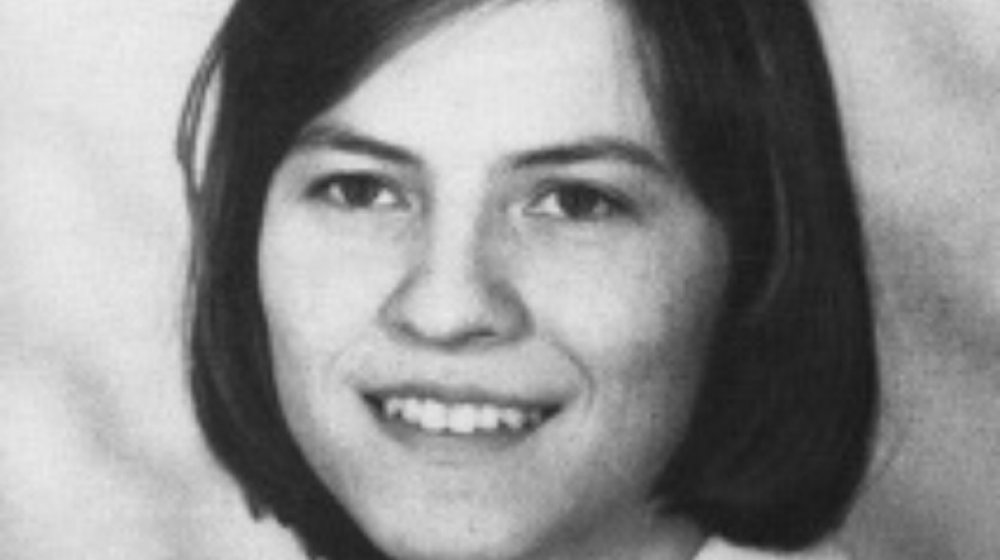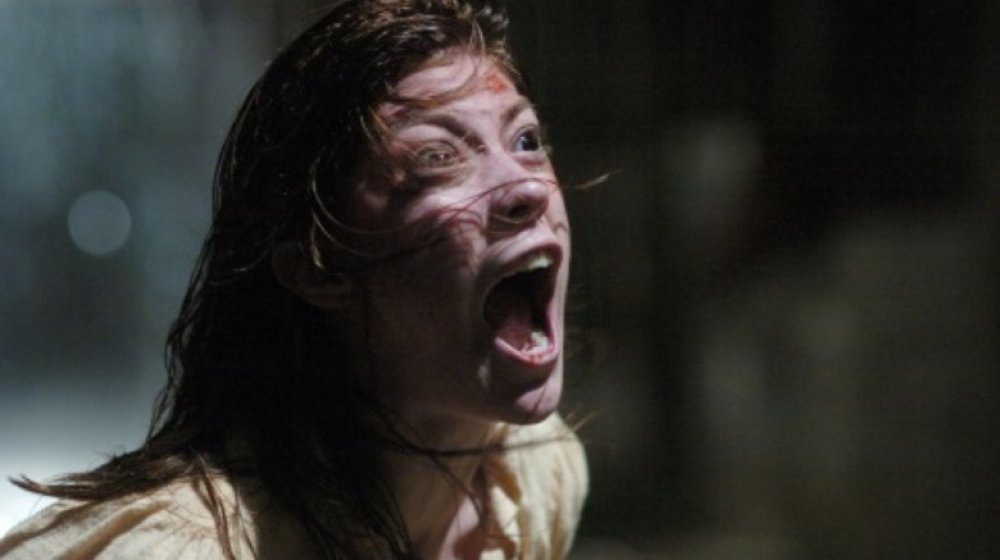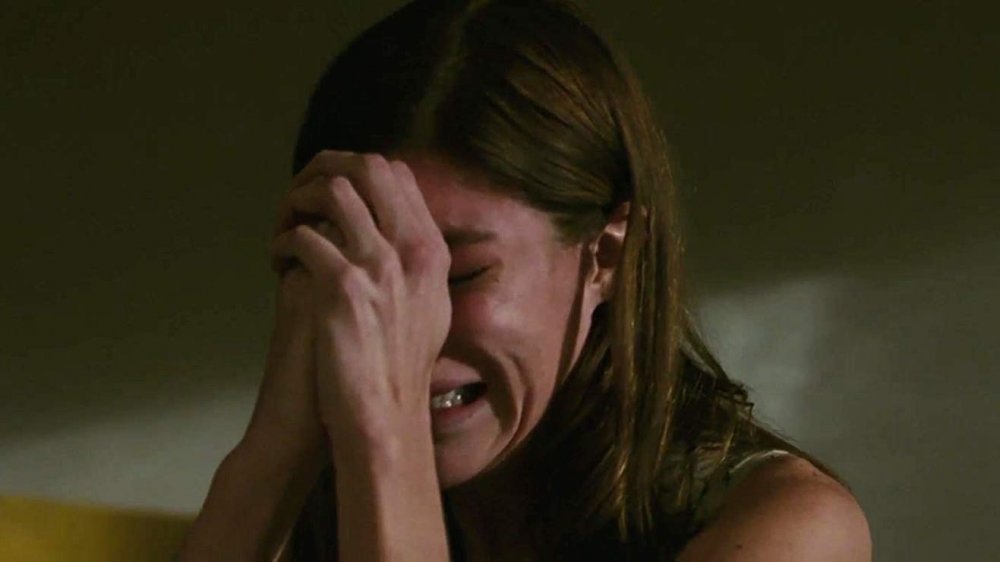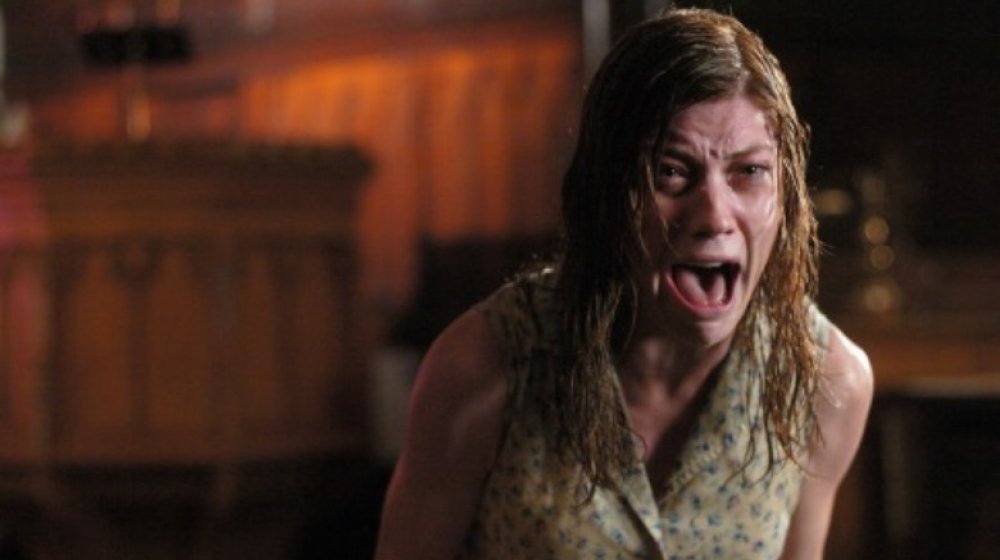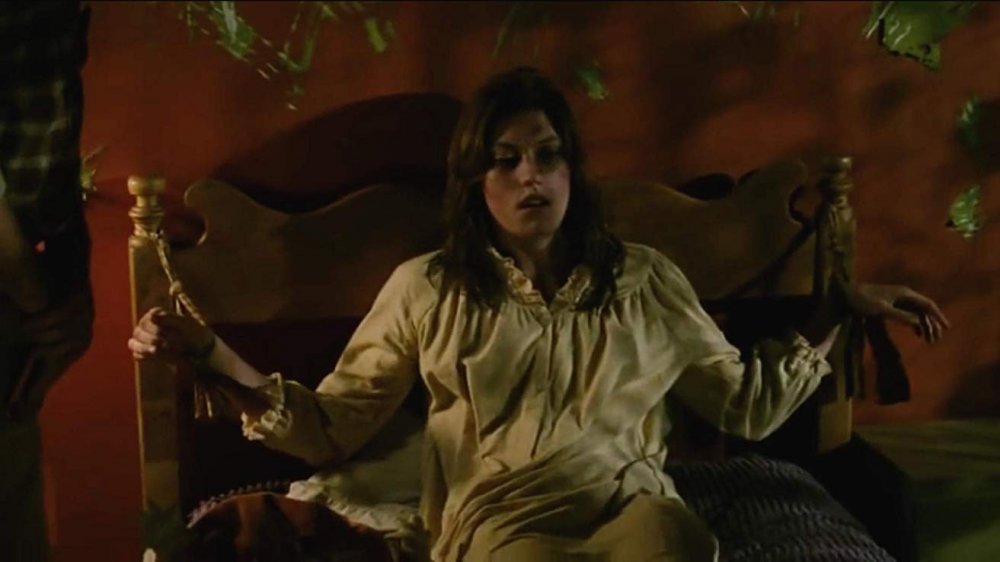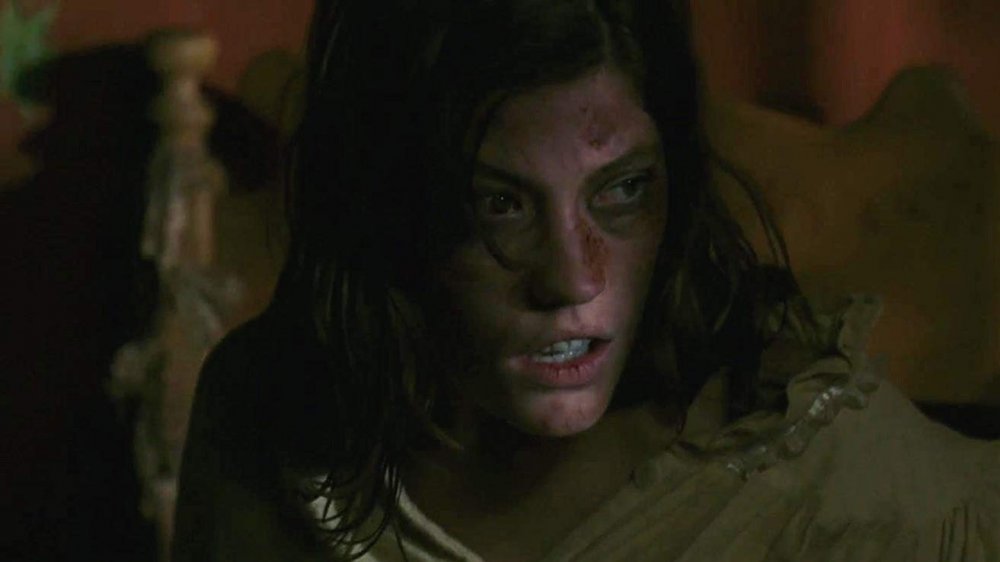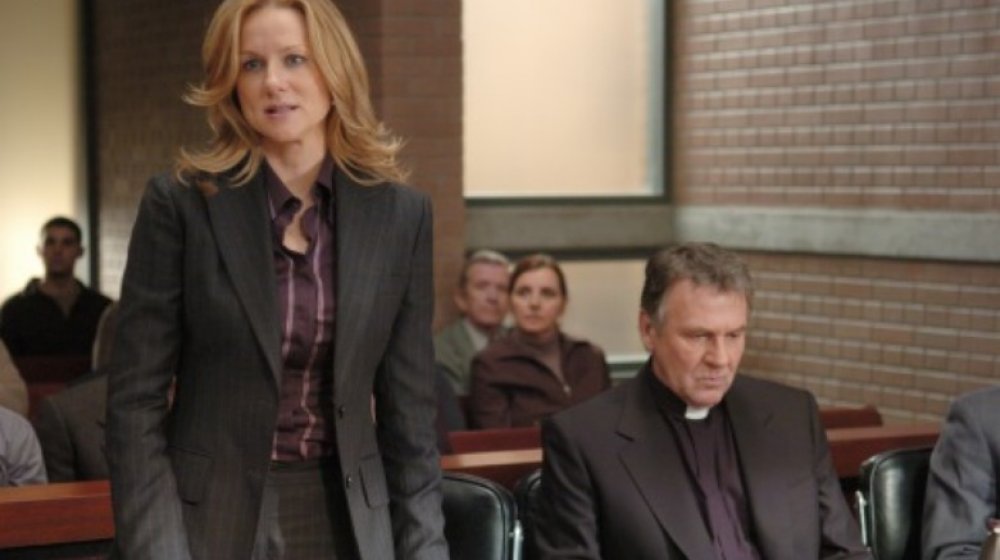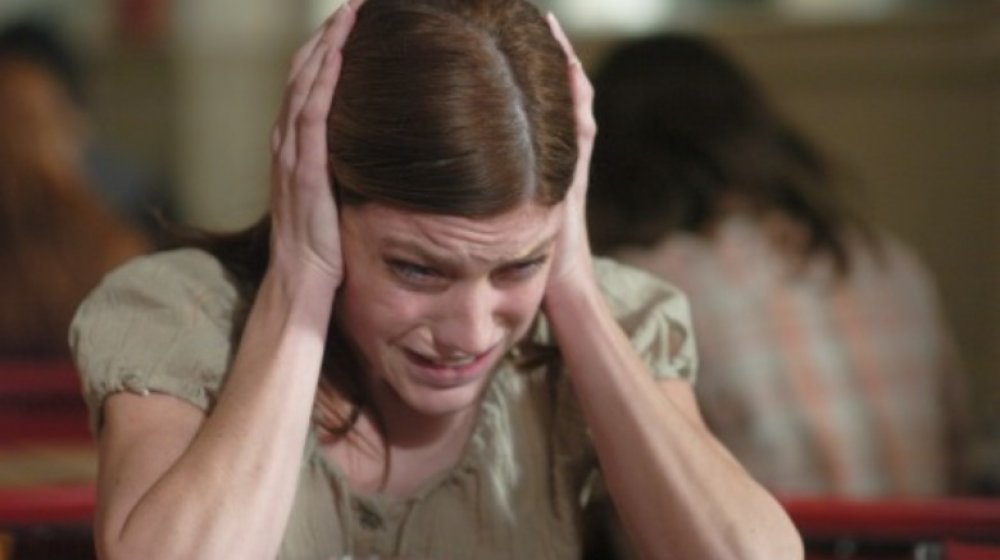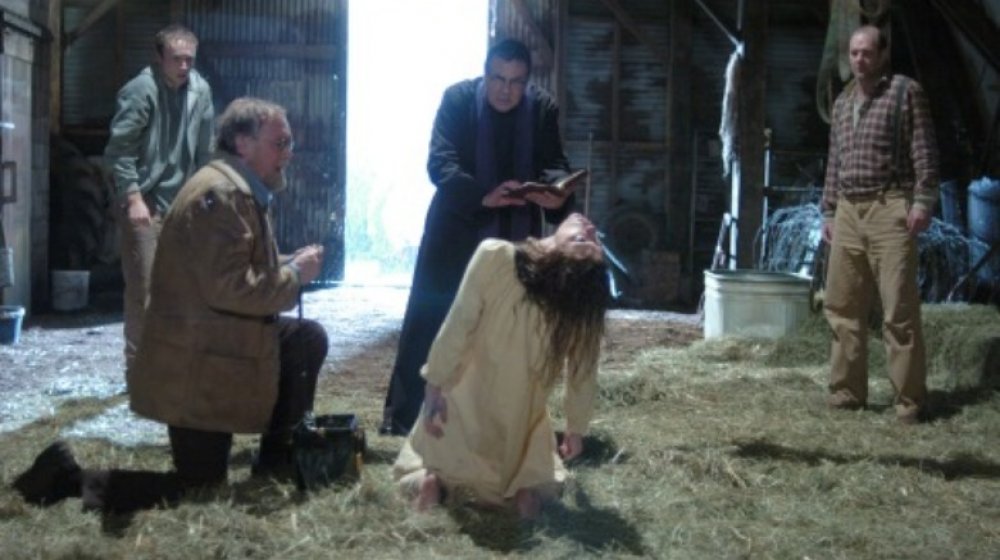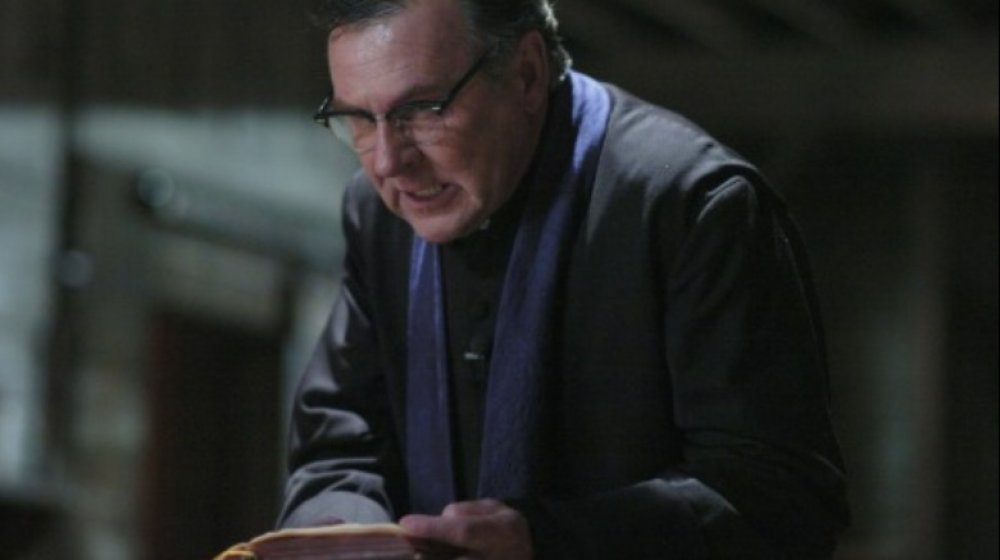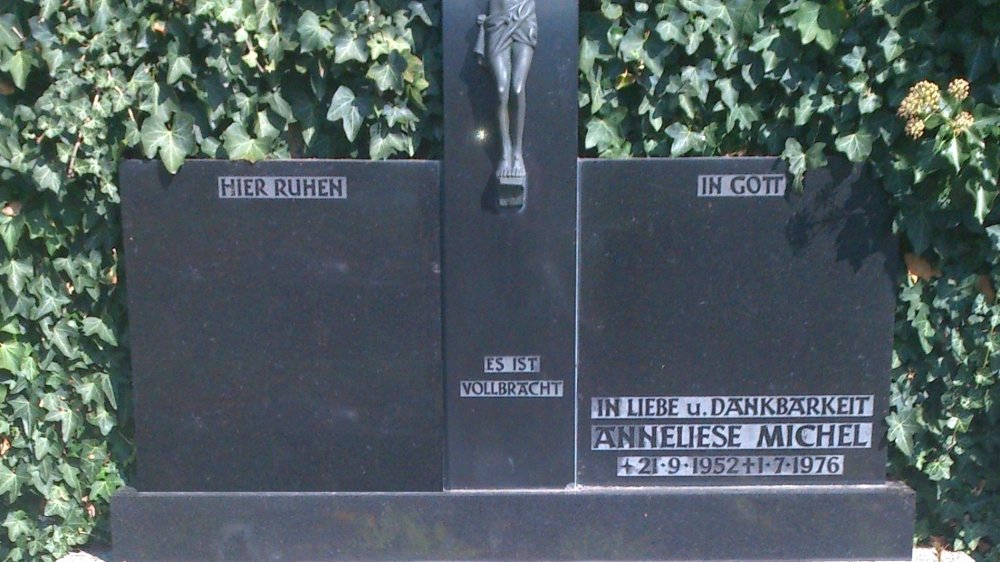The Truth Behind The Exorcism Of Anneliese Michel
Since 1973's landmark horror film The Exorcist, possessed people and the priests who try to help them have been such a common trope in movies and TV it's easy to forget exorcism is a real practice that continues to be performed on real people to this day. It's not just a thing from horror movies, and it's not just a thing from the Middle Ages. As you read this, someone is probably being exorcised somewhere in the world at this very moment.
A stark reminder of this the harrowing real-life tale of Anneliese Michel, a young woman who died in the throes of (no pun intended) an unholy number of exorcisms. This didn't happen in some pre-Enlightenment era or in some third world country. It happened in 1976 in Germany, a country considered one of the more rational and advanced countries in Europe. The story of how this could happen and the sensational aftermath serve as a chilling reminder of just how real the practice of exorcism remains.
Anneliese Michel's early life
Although the story of Anneliese Michel sounds like the kind of terrifying thing that occurred regularly in pre-modern eras like the burn-at-the-stake-happy Middle Ages, the fact is this horrifying scenario took place less than 50 years ago. Anneliese Michel was born in the small town of Klingenberg, Bavaria, in Western Germany in 1952 and met her tragic end at age 23 in 1976.
Michel was born into an extremely devout Catholic family. As Michel's mother told the Telegraph in 2005, she (the mother) had a child out of wedlock in 1948, bringing such shame on her family that she was made to wear black on her wedding day. The mother tried so hard to atone for her sin that she went to great extremes with her piety by the time Anneliese was born, rejecting the reforms the Catholic church brought on with Vatican II. Additionally, her father had considered becoming a priest and three of her aunts were nuns. As a result, Anneliese, a naturally sensitive girl, felt pressured to atone for the sins of others around her, including sleeping on the floor as penance for drug addicts who themselves slept on the ground at the train station or elsewhere. This family setting would only serve as a launchpad for a real-life nightmare by the time Anneliese was diagnosed with both physical and mental disorders as a teenager.
The possession (or not) of Anneliese Michel
According to All That's Interesting, Anneliese began experiencing blackouts at age 16 in 1968. At first she would walk around in a trance, unaware of what she was doing, or wet the bed. Soon she was experiencing convulsions. A neurologist diagnosed her with temporal lobe epilepsy, which can cause seizures, memory loss, and hallucinations. Furthermore, it can cause a disorder known as Geschwind syndrome, which causes one to act in an excessively religious manner. She began to take medication for her epilepsy and enrolled in the University of Würzburg in 1973. However, despite the treatment she was receiving, her condition worsened and she fell into a deep depression and considered suicide. She heard voices telling her she was damned and saw the face of the devil all around her. It was then she became convinced she was possessed by a demon.
As the Washington Post reports, others first became convinced of Anneliese's possession when she could not walk past a certain image of Jesus while on a pilgrimage, refused to drink holy water, and gave off a strong, hellish smell. An exorcist from a town nearby confirmed her possession, but Anneliese's request for exorcism from her local priest was twice denied, with the response being the bishop had to approve the rite. Unfortunately for all involved, it wouldn't take long before the bishop and priests changed their minds.
Anneliese Michel's disturbing behavior
As Anneliese's mother told the Telegraph, things got considerably worse than just not being able to walk past a picture of Jesus or hearing voices. Soon Anneliese was compulsively doing hundreds of squats and genuflections a day–400 to 600 by most accounts–until she eventually ruptured the ligaments in her knees. At one point she crawled under a table and stayed there, barking like a dog, for two days. She ate spiders and coal, and bit the head off of a dead bird (where, one might ask, did she get these things, but some mysteries will never be answered). Her screaming could be heard for hours at a stretch through the walls, and she was also known to urinate on the floor and then lick it up. None of this seemed like normal teen behavior, and Anneliese's family wanted to seek further psychiatric treatment for their daughter, but Anneliese refused, begging for religious intercession. Perhaps influenced by the hugely successful then-new film The Exorcist, Anneliese demanded an exorcist of her own.
In 1975, she got her wish. The local bishop, Josef Stangl, approved Anneliese's third request after she received support from a priest named Ernest Alt who believed her condition was more than just epilepsy and hallucinations. The bishop assigned Pastor Arnold Renz to work together with Father Alt to perform an exorcism rite from 1614 under the condition they did so in total secret.
Anneliese Michel's celebrity demons
The rite of exorcism was performed on Anneliese Michel for the first–but by no means the last–time by Father Renz on September 24, 1975. Over the course of her various sessions with the priest, Anneliese revealed the names of many of the more notable demons who possessed her. As it turns out, her body was something like a VIP section for the damned. Souls you would probably have thought of as evil-doing humans rather than proper demons contended for dominance within her. According to the Washington Post, Anneliese served as host to the souls of history's greatest villains: Cain, Judas, Nero, Lucifer, and Hitler, among others. These dark souls would speak through Anneliese, intoning evil wisdom and even dunking on each other. Hitler–who, according to Annliese's mother, would speak with an appropriately Austrian accent–would declare that people are as stupid as pigs, which does seem consistent with his philosophy. Meanwhile, Judas would retort Hitler was not actually a big deal in Hell but just talked a big game. No word on whether Judas spoke with an Aramaic accent, but it does make sense he would not be impressed with Hitler's antisemitism.
Furthermore, Buzzfeed claims one of Anneliese's demons was excommunicated priest Valentin Fleischmann, and even though Anneliese should not have known anything about him, she was able to provide accurate details of the naughty behavior that got him booted from the church.
The many exorcisms of Anneliese Michel
Over the course of nine months, sessions lasting up to four hours were held once or twice a week in an attempt to drive Judas and company out of Anneliese Michel. All told, as the Washington Post explains, Anneliese was subjected to a total of 67 exorcisms. This, by any metric, is a lot. Father Renz allowed some of the sessions to be recorded, and some 42 hours of audio of the exorcisms of Anneliese Michel exists, and what those tapes contain is horrifying.
Michel's voice on the recordings is inhuman and demon-like. She gurgles, growls, hisses, and spits obscenities in between sessions of Judas and Hitler arguing and explicating the terrors of Hell. The Post notes that Michel's voice on these tapes sounds remarkably like Linda Blair's in The Exorcist, but your mileage may vary on that. During these sessions, even as Anneliese wasted away physically, she exhibited what witnesses described as superhuman strength, and her behavior would become so violent that she would have to be held down, chained to her chair, or otherwise restrained so that the priests would be able to continue performing their rites. It was around this time that Anneliese broke all the bones and ripped all the tendons in her knees from kneeling so much. Honestly, being chained down might have been the preferable alternative to all that.
The death of Anneliese Michel
Getting chained to a chair for four hours 67 times in nine months so priests can yell at you and throw water on you and so the power of Christ can compel you would take a lot out of anyone, but, in one of the more shocking details of this case, it wasn't actually all the exorcism that killed Anneliese Michel. As the Washington Post explains, Anneliese's sense of responsibility to atone for the sins of her generation did not end just because of the near ceaseless exorcism rituals. During the nine month period of her exorcisms, Anneliese began talking about the possibility of sacrificing her own life on behalf of the rebellious youth and sinful priests she considered to be plaguing the modern era. By this point she had requested not to be treated medically for her epilepsy any longer, relying fully on the priests' exorcisms, and had stopped eating altogether, planning to starve herself to death to atone for the sins of others.
The Telegraph says by the spring of 1976 Anneliese was emaciated and had contracted pneumonia. Exhausted from the brutal exorcism sessions, suffering from a fever, and weakened from not eating, Anneliese Michel died of starvation and dehydration on July 1, 1976, weighing a mere 68 pounds, at just 23 years of age. The end of Anneliese's life, however, was hardly the end of the story.
Anneliese Michel's parents on trial
If you find yourself feeling angry Anneliese's parents and the priests would be so irresponsible as to let a young woman slowly starve to death in front of their eyes for basically no reason, don't worry: you're not alone. As Skeptoid explains, Anneliese's parents and both Father Alt and Father Lenz were arrested and charged with negligent homicide for failing to get Anneliese the necessary medical care in her final days. While it was recognized Anneliese's organ failure was inevitable towards the end, experts found Anneliese could have been saved even a week before her death with the most basic medical care. However, the prosecution recognized the Michels had pursued practically every possible avenue to help their daughter and asked the court merely to charge the priests a fine and find the parents guilty but give them no punishment as they had suffered enough.
To give this already sensational trial an even more lurid edge, the Michels had Anneliese's body exhumed before the trial because a nun had told them she had had a vision Anneliese's body was incorrupt in the grave. If this turned out to be true, it would be evidence something supernatural truly was afoot and the exorcism was warranted. Suffice it to say, the body turned out to have followed the natural course of decomposition.
How Anneliese Michel's death became a referendum on religion
In the Anneliese Michel trial, more was at stake than merely the guilt of two parents and two priests. As the Washington Post explains, the trial also served as a referendum of sorts on the issue of science and reason versus religion. In comparison to some other European nations, Germany is considered highly rational and secular. For example, in Italy nearly half a million exorcisms are performed each year, and about one fifth of the world's practicing exorcists live in France. By comparison, Germany has only two or three practicing exorcists, who perform in secret under the bishop's approval. Even among baptized Christians in Germany, about one third of Catholics and half of Protestants don't believe in life after death.
As such, as a country that prides itself on secularism, German officials didn't want to be seen going on the record as considering the presence of the Devil as a legitimate defense. At the same time, the Church has a vested interest in maintaining Satan is real: if demons don't exist and priests can't exhibit control over them in the name of Christ, elements of the Bible come into doubt, which could lead an already secular nation into questioning religion even more. While the court did hear the arguments in favor of Anneliese's possession, in general the case was handled in a way that downplayed the existence of the Devil.
Anneliese Michel's parents sentenced
Over the course of the trial, the tapes of the Anneliese Michel exorcism sessions were played in court as evidence Anneliese was possessed, with clips of the demons arguing being used to prop up this claim. Furthermore, the Michels' church-sponsored attorney argued exorcism is legal and protected under the German constitution's guarantee of religious freedom. The prosecution, meanwhile, naturally produced doctors who testified Anneliese was not possessed, but that she suffered from psychological effects brought on by both her unusually religious background and her epilepsy.
As Skeptoid explains, all four defendants were found guilty, not of negligent homicide, but of the lesser charge of negligent manslaughter. However, while the court gave a more lenient sentence than the public had expected, it was not as lenient as the prosecution had suggested. While the state had argued the parents should suffer no punishment and the priests should merely pay a fine, the court gave them all six month prison sentences, which were suspended, and three years' probation. Despite the guilty verdict, the Michels remained convinced they had done the right thing. Anneliese's mother said the exorcisms were justified because Anneliese's hands had borne stigmata as a sign the demons should be driven out so Anneliese could atone for the sins of others. She said she did not regret her daughter's death as she was convinced there was no other course of action.
The failed reform following Anneliese Michel's death
The Anneliese Michel trial became a huge media spectacle, and German priests found themselves embarrassed to be associated with what they considered old-fashioned practices, especially the fact the rite of exorcism used on Anneliese dated back to 1614. According to Skeptoid, many within the German church made a concerted effort to modernize the church's rules about exorcism. German bishops and theologians formed a commission to review the church's practices and in 1984, they petitioned the Vatican to reform their approach to exorcism.
Namely, the German commission was concerned about the constant use of direct address of the demons during the rite, such as saying "I command thee, unclean spirit" and so on. The commission found this part of the ritual did the most psychological damage, because when the priest addresses the demon instead of the patient, what the patient sees is an authority figure confirming the presence of a demon inside them, which only worsens the delusion that is often at the heart of possession cases. The petition by the German commission specifically asked the Vatican to remove and indeed forbid this part of the rite. It took 15 years for the Vatican to return a decision on the case, and when they finally addressed the issue of exorcism in 1999, the Germans did not get what they wanted. The new revised exorcism formula still included the possibility of speaking directly to the Devil within the patient.
The pilgrimage to Anneliese Michel's grave
In the years since the Anneliese Michel trial, the young woman's death has continued to haunt the town of Klingenberg. According to the Telegraph, the town's residents are embarrassed and prefer not to talk about it, even as pilgrims pour into the town to visit Anneliese's grave. All That's Interesting contends these pilgrims view Anneliese as a symbolic counter to the increased secularism of modern interpretations of the Bible that deny what they feel are deep, miraculous truths. Some pilgrims believe Anneliese's grave can purify souls, a belief that would probably please Anneliese, who felt so strongly that her death would atone for the sins of others. For some, Anneliese Michel is something of an unofficial saint.
Buses of pilgrims still flock to Anneliese's grave, where those who feel outside the religious mainstream gather to pray, sing songs, and leave notes to Anneliese requesting help the way one might petition a saint. The number of visitors only increased after the release of movies inspired by her story. Anneliese's mother said in 2005, still living in the house where her daughter died decades later and within eyeshot of her daughter's grave, that she had a prayer she would hand out to visitors to be said daily, thanking God that Anneliese's sacrifice showed young sinners how they can devote their lives to the will of God.
Anneliese Michel's pop culture legacy
While the story of Anneliese Michel's life and tragic death would be of interest to those who look into the stranger, darker corners of history, or those who want evidence to support the idea that exorcism is an archaic and even barbaric practice, it likely would not have entered the public consciousness to the degree that it has if it weren't for the film adaptations of the story.
The most notable of these is 2005's The Exorcism of Emily Rose, which used the real-life story of Anneliese Michel as a loose framework on which to build its story, which featured changed names and a relocation to America. The main point of interest for the filmmakers seems to have been the trial, as the story focuses on the trial of a priest charged with negligent homicide after an exorcism case turned deadly. The movie received what could charitably be called mixed reviews.
The 2006 German drama film Requiem and the 2011 found footage horror film Anneliese: The Exorcist Tapes (also known as Paranormal Entity 3: The Exorcist Tapes, an Asylum mockbuster meant to capitalize on the success of Paranormal Activity 3) also take Anneliese's story as inspiration with, uh, varying degrees of reverence for a real human who died. Anneliese's story has also been told through the Public Image Ltd. song "Annalisa" and episodes of Buzzfeed Unsolved and My Favorite Murder.
